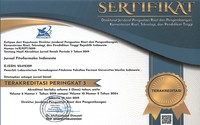Radiolabeled curcumin as β amyloid imaging and tumor targeting imaging agents
Abstract
Keywords
Full Text:
PDFReferences
Alauddin, M. M. (2012) Positron emission tomography (PET) imaging with (18)F-based radiotracers. Am J Nucl Med Mol Imaging, 2(1), pp. 55-76.
Asti, M., Ferrari, E., Croci, S., Atti, G., Rubagotti, S., Iori, M., Capponi, P. C., Zerbini, A., Saladini, M. and Versari, A. (2014) Synthesis and characterization of (68)Ga-labeled curcumin and curcuminoid complexes as potential radiotracers for imaging of cancer and Alzheimer's disease. Inorg Chem, 53(10), pp. 4922-33.
Bailey, D. L., Maisey, M. N., Townsend, D. W. and Valk, P. E. (2005) Positron Emission Tomography. Basic Sciences, London, UK: Springer-Verlag London Limited.
Banez, M. J., Geluz, M. I., Chandra, A., Hamdan, T., Biswas, O. S., Bryan, N. S. and Von Schwarz, E. R. (2020) A systemic review on the antioxidant and anti-inflammatory effects of resveratrol, curcumin, and dietary nitric oxide supplementation on human cardiovascular health. Nutr Res, 78, pp. 11-26.
Boschi, A., Uccelli, L. and Martini, P. (2019) A Picture of Modern Tc-99m Radiopharmaceuticals: Production, Chemistry, and Applications in Molecular Imaging. Applied Sciences, 9(12), pp. 2526.
Budson, A. E. and Solomon, P. R. (2012) New criteria for Alzheimer disease and mild cognitive impairment: implications for the practicing clinician. Neurologist, 18(6), pp. 356-63.
Chen, J., He, Z. M., Wang, F. L., Zhang, Z. S., Liu, X. Z., Zhai, D. D. and Chen, W. D. (2016) Curcumin and its promise as an anticancer drug: An analysis of its anticancer and antifungal effects in cancer and associated complications from invasive fungal infections. Eur J Pharmacol, 772, pp. 33-42.
Cui, M., Ono, M., Kimura, H., Liu, B. and Saji, H. (2011) Synthesis and Structure−Affinity Relationships of Novel Dibenzylideneacetone Derivatives as Probes for β-Amyloid Plaques. Journal of Medicinal Chemistry, 54(7), pp. 2225-2240.
Cunha, L., Szigeti, K., Mathe, D. and Metello, L. F. (2014) The role of molecular imaging in modern drug development. Drug Discov Today, 19(7), pp. 936-48.
DeKosky, S. T. and Marek, K. (2003) Looking backward to move forward: early detection of neurodegenerative disorders. Science, 302(5646), pp. 830-4.
Dubost, E., McErlain, H., Babin, V., Sutherland, A. and Cailly, T. (2020) Recent Advances in Synthetic Methods for Radioiodination. J Org Chem, 85(13), pp. 8300-8310.
Effendi, N., Mishiro, K., Takarada, T., Makino, A., Yamada, D., Kitamura, Y., Shiba, K., Kiyono, Y., Odani, A. and Ogawa, K. (2018) Radiobrominated benzimidazole-quinoline derivatives as Platelet-derived growth factor receptor beta (PDGFRbeta) imaging probes. Sci Rep, 8(1), pp. 10369.
Effendi, N., Mishiro, K., Takarada, T., Yamada, D., Nishii, R., Shiba, K., Kinuya, S., Odani, A. and Ogawa, K. (2019) Design, synthesis, and biological evaluation of radioiodinated benzo[d]imidazole-quinoline derivatives for platelet-derived growth factor receptor beta (PDGFRbeta) imaging. Bioorg Med Chem, 27(2), pp. 383-393.
Fass, L. (2008) Imaging and cancer: a review. Mol Oncol, 2(2), pp. 115-52.
Filippi, L., Chiaravalloti, A., Bagni, O. and Schillaci, O. (2018) (18)F-labeled radiopharmaceuticals for the molecular neuroimaging of amyloid plaques in Alzheimer's disease. Am J Nucl Med Mol Imaging, 8(4), pp. 268-281.
Galban, C. J., Galban, S., Van Dort, M. E., Luker, G. D., Bhojani, M. S., Rehemtulla, A. and Ross, B. D. (2010) Applications of molecular imaging. Prog Mol Biol Transl Sci, 95, pp. 237-98.
Heger, M., van Golen, R. F., Broekgaarden, M. and Michel, M. C. (2014) The molecular basis for the pharmacokinetics and pharmacodynamics of curcumin and its metabolites in relation to cancer. Pharmacol Rev, 66(1), pp. 222-307.
Hewlings, S. J. and Kalman, D. S. (2017) Curcumin: A Review of Its Effects on Human Health. Foods, 6(10).
IAEA (2009) Technetium-99m Radiopharmaceuticals: Status and Trends, Radioisotopes and Radiopharmaceuticals Series No. 1, Vienna: IAEA.
Jack, C. R., Jr., Bennett, D. A., Blennow, K., Carrillo, M. C., Dunn, B., Haeberlein, S. B., Holtzman, D. M., Jagust, W., Jessen, F., Karlawish, J., Liu, E., Molinuevo, J. L., Montine, T., Phelps, C., Rankin, K. P., Rowe, C. C., Scheltens, P., Siemers, E., Snyder, H. M., Sperling, R. and Contributors (2018) NIA-AA Research Framework: Toward a biological definition of Alzheimer's disease. Alzheimers Dement, 14(4), pp. 535-562.
Kim, H., Im, Y. H., Ahn, J., Yang, J., Choi, J. Y., Lee, K. H., Kim, B. T. and Choe, Y. S. (2019) Synthesis and in vivo characterization of (18)F-labeled difluoroboron-curcumin derivative for beta-amyloid plaque imaging. Sci Rep, 9(1), pp. 6747.
Kumar, C., Subramanian, S. and Samuel, G. (2016) Evaluation of radioiodinated curcumin for its potential as a tumor-targeting radiopharmaceutical. Journal of Radiation and Cancer Research, 7, pp. 112 - 116.
Kunwar, A., Barik, A., Mishra, B., Rathinasamy, K., Pandey, R. and Priyadarsini, K. I. (2008) Quantitative cellular uptake, localization and cytotoxicity of curcumin in normal and tumor cells. Biochim Biophys Acta, 1780(4), pp. 673-9.
Lee, I., Yang, J., Lee, J. H. and Choe, Y. S. (2011) Synthesis and evaluation of 1-(4-[(1)(8)F]fluoroethyl)-7-(4'-methyl)curcumin with improved brain permeability for beta-amyloid plaque imaging. Bioorg Med Chem Lett, 21(19), pp. 5765-9.
Mankoff, D. A. (2007) A definition of molecular imaging. J Nucl Med, 48(6), pp. 18N, 21N.
Martiniova, L., Palatis, L., Etchebehere, E. and Ravizzini, G. (2016) Gallium-68 in Medical Imaging. Curr Radiopharm, 9(3), pp. 187-207.
Orteca, G., Pisaneschi, F., Rubagotti, S., Liu, T. W., Biagiotti, G., Piwnica-Worms, D., Iori, M., Capponi, P. C., Ferrari, E. and Asti, M. (2019) Development of a Potential Gallium-68-Labelled Radiotracer Based on DOTA-Curcumin for Colon-Rectal Carcinoma: From Synthesis to In Vivo Studies. Molecules, 24(3).
Perrone, D., Ardito, F., Giannatempo, G., Dioguardi, M., Troiano, G., Lo Russo, L., A, D. E. L., Laino, L. and Lo Muzio, L. (2015) Biological and therapeutic activities, and anticancer properties of curcumin. Exp Ther Med, 10(5), pp. 1615-1623.
Reiman, E. M. and Jagust, W. J. (2012) Brain imaging in the study of Alzheimer's disease. Neuroimage, 61(2), pp. 505-16.
Rubagotti, S., Croci, S., Ferrari, E., Iori, M., Capponi, P. C., Lorenzini, L., Calza, L., Versari, A. and Asti, M. (2016) Affinity of (nat/68)Ga-Labelled Curcumin and Curcuminoid Complexes for beta-Amyloid Plaques: Towards the Development of New Metal-Curcumin Based Radiotracers. Int J Mol Sci, 17(9).
Ryu, E. K., Choe, Y. S., Lee, K. H., Choi, Y. and Kim, B. T. (2006) Curcumin and dehydrozingerone derivatives: synthesis, radiolabeling, and evaluation for beta-amyloid plaque imaging. J Med Chem, 49(20), pp. 6111-9.
Sagnou, M., Benaki, D., Triantis, C., Tsotakos, T., Psycharis, V., Raptopoulou, C. P., Pirmettis, I., Papadopoulos, M. and Pelecanou, M. (2011) Curcumin as the OO Bidentate Ligand in “2 + 1” Complexes with the [M(CO)3]+ (M = Re, 99mTc) Tricarbonyl Core for Radiodiagnostic Applications. Inorganic Chemistry, 50(4), pp. 1295-1303.
Shin, S., Koo, H.-J., Lee, I., Choe, Y. S., Choi, J. Y., Lee, K.-H. and Kim, B.-T. (2015) Synthesis and characterization of 18F-labeled hydrazinocurcumin derivatives for tumor imaging. RSC Advances, 5(117), pp. 96733-96745.
Takizawa, C., Thompson, P. L., van Walsem, A., Faure, C. and Maier, W. C. (2015) Epidemiological and economic burden of Alzheimer's disease: a systematic literature review of data across Europe and the United States of America. J Alzheimers Dis, 43(4), pp. 1271-84.
Triantis, C., Tsotakos, T., Tsoukalas, C., Sagnou, M., Raptopoulou, C., Terzis, A., Psycharis, V., Pelecanou, M., Pirmettis, I. and Papadopoulos, M. (2013) Synthesis and Characterization of fac-[M(CO)3(P)(OO)] and cis-trans-[M(CO)2(P)2(OO)] Complexes (M = Re, 99mTc) with Acetylacetone and Curcumin as OO Donor Bidentate Ligands. Inorganic Chemistry, 52(22), pp. 12995-13003.
Uzuegbunam, B. C., Librizzi, D. and Hooshyar Yousefi, B. (2020) PET Radiopharmaceuticals for Alzheimer's Disease and Parkinson's Disease Diagnosis, the Current and Future Landscape. Molecules, 25(4).
Walker, B. C. and Mittal, S. (2020) Antitumor Activity of Curcumin in Glioblastoma. Int J Mol Sci, 21(24).
Zhao, J., Zhu, J., Lv, X., Xing, J., Liu, S., Chen, C. and Xu, Y. (2017) Curcumin potentiates the potent antitumor activity of ACNU against glioblastoma by suppressing the PI3K/AKT and NF-kappaB/COX-2 signaling pathways. Onco Targets Ther, 10, pp. 5471-5482.
Zhu, H. T., Bian, C., Yuan, J. C., Chu, W. H., Xiang, X., Chen, F., Wang, C. S., Feng, H. and Lin, J. K. (2014) Curcumin attenuates acute inflammatory injury by inhibiting the TLR4/MyD88/NF-kappaB signaling pathway in experimental traumatic brain injury. J Neuroinflammation, 11, pp. 59.
DOI: https://doi.org/10.33096/jffi.v8i3.708
Copyright (c) 2021 Jurnal Fitofarmaka Indonesia

This work is licensed under a Creative Commons Attribution-ShareAlike 4.0 International License.
Indexed by:
ISSN: 2356-0398 | e-ISSN: 2541-2329
Editor's Address:
Third Floor Pharmacognosy-phytochemistry laboratory building, Urip Sumoharjo road km. 5 Campus II UMI, Makassar, South Sulawesi, Indonesia
Phone: +6281524045514
Fax: +62411425619
E-mail: editorjfi@umi.ac.id

















.jpg)

